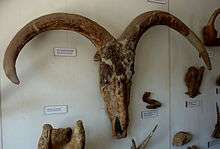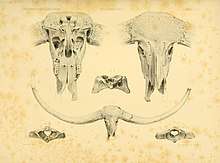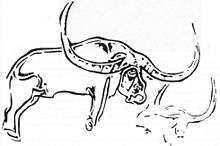Pelorovis
Pelorovis ("prodigious/monstrous sheep") is an extinct genus of African wild cattle, which first appeared in the very beginning of the Pleistocene, 2.5 million years ago,[1] and became extinct at the end of the Late Pleistocene about 12,000 years ago or even during the Holocene, some 4,000 years ago.[2]
| Pelorovis | |
|---|---|
| P. antiquus skull on display at the Nairobi National Museum | |
| Scientific classification | |
| Kingdom: | Animalia |
| Phylum: | Chordata |
| Class: | Mammalia |
| Order: | Artiodactyla |
| Family: | Bovidae |
| Subfamily: | Bovinae |
| Genus: | †Pelorovis Reck, 1928 |
| Species | |
| |
Taxonomy
The genus was first described by Hans Reck in 1928 to house his new species P. oldowayensis, which he described from bones originally found by him in Olduvai Gorge in northern German East Africa (Tanzania) in 1913, the first ever time this famous locality was explored by a palaeontologist. Hence, the type species is P. oldowayensis by monotypy. The holotype is a fossil skull and assorted bones kept in Berlin.
The first fossil known was a skull discovered along the Bou Sellam River near the city of Sétif, Algeria, at one meter in depth, when excavating the foundations of a new mill, and subsequently sent to Paris by one M. Favre de Ribauvillers.[3][4] This, now classified as P. antiquus, was originally classified as a type of water buffalo by Georges Louis Duvernoy, who described it under the name Bubalus (Arni) antiquus in 1851. With some awe, Duvernoy states of the skull: "c'est ... remarquable par ses grandes dimensions, qui m'a révélé l'existence passée de cette espéce".[3] It was moved to Pelorovis in 1978.[5] P. antiquus was then subsequently moved to Syncerus in 1994, which has been subsequently followed by many authors.[6]
The species P. kaisensis was named in 1994 from Kaiso, Uganda. Hadjouis and Sahnouni considered it to be closer to Syncerus in 2005.[5]
Systematics
A 2007 study by Bienvenido Martínez-Navarro and colleagues of the morphology of the fossil remains came to the conclusion that Pelorovis is probably not monophyletic. These authors reclassify the early forms of the genus, P. turkanensis and P. oldowayensis, in the genus Bos. In contrast, they find that the late Pleistocene form Pelorovis antiquus seems to be a close relative of the modern African buffalo (Syncerus caffer). This approach essentially subsumes the genus as a synonym of Bos, because the type species is P. oldowayensis.[5] A number of the authors of this study reiterated their classification of the taxa Pelorovis turkanensis and P. oldowayensis in the genus Bos in another paper published 2014.[7] Alexandre Hassanin follows the interpretations of Martínez-Navarro et al., pointing to previous genetics work which show that the bovid lineages which produced the modern species within the genera Bos, Bubalus and Syncerus split from each other some eight to nine million years ago, indicating that either the fossil ancestors of these species have not yet been discovered, or that they already have been found, but are taxonomically misidentified. He further points out that Martínez-Navarro et al. are only looking for the ancestor of Bos primigenius in their studies of African fossil bovids, and that the Asian species of Bos may have been derived from other fossil species. Lastly, Hassanin notes that if Pelorovis is reduced into synonymy due to these studies, this also implies the other Pleistocene fossil genera Leptobos and Epileptobos are synonymous with Bos.[8] A 2018 study by Tong et al. of the Chinese fossil representation of Bos primigenius uses morphology to dispute these conclusions regarding these taxa belonging to the genus Bos, as well as if they are the ancestral line from which Bos evolved, instead hewing to the traditional interpretation that the Indian Early Pleistocene fossil species Bos acutifrons is the primordial ancestor of Bos.[9]
Description

Pelorovis resembled an African buffalo, although it was larger and possessed longer, curved horns. Pelorovis probably weighed about 1,200 kilograms (2,600 lb), with the largest males attaining 2,000 kilograms (4,400 lb). This ranks it as one of the largest bovines, and indeed one of the largest ruminants ever to have lived, rivalling the extinct American long-horned bison (Bison latifrons), and the extinct Asiatic giraffid Sivatherium giganteum, as well as the extant African giraffe (Giraffa camelopardis) in weight. The bony cores of the horns were each about 1 metre (3.3 ft) long; when covered with keratin (which does not survive fossilisation) they could have been up to twice this length.[12] The horns pointed away from the head, each forming a half circle in the species Pelorovis oldowayensis and P. turkanensis.[1]

The horns of P. antiquus were even more magnificent. These traced a regular circular arc, with the bone cores of the first known skull reaching 2.4 metres (7.9 ft) in length and resembling in shape those of the Wild Water Buffalo (Bubalus).[4] P. oldowayensis was broadly the same size as modern African buffalo, but its legs were longer, and the elongated head of this species was reminiscent to those of the modern Alcelaphinae. P. antiquus was more robust. According to Auguste Pomel, who was able to examine numerous fossils in Algeria, in life P. antiquus reached 3 metres (9.8 ft) in length from muzzle to the end of the tail, 1.85 metres (6.1 ft) in height at the withers, and 1.7 metres (5.6 ft) in height at the hindquarters.[4][13]
Distribution
P. antiquus disappeared around 12,000 years ago from southern and eastern Africa. Fossil and archaeological evidence indicates that this species lived in North Africa until 4,000 years ago.[2] P. oldowayensis occurred in sub-Saharan Africa and disappeared 800,000 years ago.
The best fossils of P. oldowayensis are known from the Olduvai Gorge in Tanzania; a complete skeleton of P. antiquus was found near Djelfa in Algeria.
Ecology
Pelorovis antiquus was originally recovered from a formerly flooded ("diluvien") area.[3] With such vast horns, it seems clear that the species inhabited regions with few trees. Judging from the rock art, it seems pairs of the male animals (testes are illustrated) would fight by ramming each other's horns with their heads lowered -this is illustrated numerous times. It also seems to have lived in largish herds, judging from some of the ancient art of Africa.[4]
Uses

A large amount of rock art has been found illustrating the species Pelorovis antiquus in the Magreb: in the Atlas, in the Sahara and nearer to the Atlantic and Mediterranean coast. The art is found in a wide band stretching from Tunisia through Algeria to Morocco. According to Georges-Barthélemy Médéric Flamand, two styles of art depicting the buffalo can be distinguished: a style found in the Sahara and the coastal/Atlas style. This art indicates these creatures were actively hunted with spears, possibly by the first of the Berber peoples.[4]
References
- Alan Turner & Mauricio Anton: Evolving Eden, An Illustrated Guide to the Evolution of the African Large-Mammal Fauna. Columbia University Press, New York 2004 ISBN 0-231-11944-5 (pp. 159-167)
- Ronald M. Nowak: Walker's Mammals of the World. Johns Hopkins University Press, 1999 ISBN 0-8018-5789-9
- Duvernoy, Georges Louis (December 1851). "note sur une espèce de buffle fossile [Bubalis (Arni) antiquus], découverte en Algérie, caractérisée et décrite par M. Duvernoy". Comptes rendus hebdomadaires des séances de l'Académie des Sciences (in French). 33: 595–597. Retrieved 8 January 2020.
- Camps, Gabriel (1992). "Bubalus antiquus". In Camps, Gabriel (ed.). Encyclopédie Berbère (online 1 March 2013) (in French). 11: Bracelets – Caprarienses. Aix-en-Provence: Edisud. pp. 1642–1647. Retrieved 8 January 2020.
- Martínez-Navarro, Bienvenido; Pérez-Claros, Juan Antonio; Palombo, Maria Rita; Rook, Lorenzo; Palmqvist, Paul (September 2007). "The Olduvai buffalo Pelorovis and the origin of Bos" (PDF). Quaternary Research. 68 (2): 220–226. Bibcode:2007QuRes..68..220M. doi:10.1016/j.yqres.2007.06.002. Retrieved 8 January 2020.
- Klein, Richard G. (November 1994). "The Long-Horned African Buffalo (Pelorovis antiquus) is an Extinct Species". Journal of Archaeological Science. 21 (6): 725–733. doi:10.1006/jasc.1994.1072.
- Martínez-Navarro, Bienvenido; Narjess, Karoui-Yaakoub; Oms, Oriol; Amri, Lamjed; López-García, Juan Manuel; Zerai, Kamel; Blain, Hugues-Alexandre; Mtimet, Moncef-Saïd; Espigares, María-Patrocinio; Ben Haj Ali, Nebiha; Ros-Montoya, Sergio; Boughdiri, Mabrouk; Agustí, Jordi; Khayati-Amma, Hayet; Maalaoui, Kamel; Om El Khir, Maahmoudi; Sala, Robert; Othmani, Abdelhak; Hawas, Ramla; Gómez-Merino, Gala; Solè, Àlex; Carbonell, Eudald; Palmqvist, Paul (April 2014). "The early Middle Pleistocene archeopaleontological site of Wadi Sarrat (Tunisia) and the earliest record of Bos primigenius". Quaternary Science Reviews. 90: 37–46. Bibcode:2014QSRv...90...37M. doi:10.1016/j.quascirev.2014.02.016. Retrieved 3 January 2020.
- Hassanin, Alexandre (January 2014). "Systematic and evolution of Bovini". In Melletti, D.R.; Burton, J. (eds.). Ecology, Evolution and Behaviour of Wild Cattle: Implications for Conservation. Cambridge University Press. pp. 7–21.
- Tong, Hao-Wen; Chen, Xi; Zhang, Bei; Wang, Fa-Gang (January 2018). "New fossils of Bos primigenius (Artiodactyla, Mammalia) from Nihewan and Longhua of Hebei, China". Vertebrata PalAsiatica. 56: 69–92. doi:10.19615/j.cnki.1000-3118.170722. Retrieved 4 January 2020.
- Liddell, Henry George; Scott, Robert (1940). "πέλωρ-". A Greek–English Lexicon. Oxford: Clarendon Press.
- Lewis, Charlton T.; Short, Charles (1879). "Ovis". A Latin Dictionary. Oxford: Clarendon Press.
- Palmer, D., ed. (1999). The Marshall Illustrated Encyclopedia of Dinosaurs and Prehistoric Animals. London: Marshall Editions. p. 281. ISBN 978-1-84028-152-1.
- Pomel, Auguste (1893). Bubalus antiquus. Carte de Géologie de l’Algérie - Paléontologie Monographies de Vertébrés (in French). Algiers: imprimerie P. Fontana. pp. 1–94, pl.1-10. doi:10.5962/bhl.title.13867.